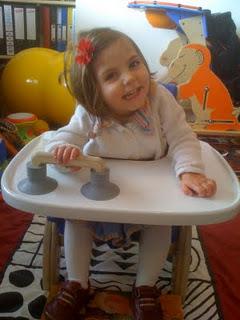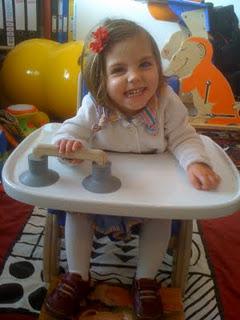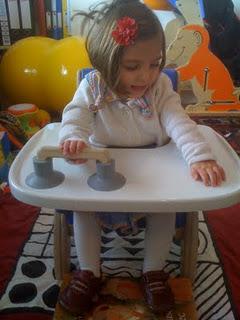Perhaps what I should have done that day was to contrast Isobel in practice with that of my friends' children. At Diana, Princess of Wales Memorial Playground - a play arena that I'd strongly recommend to any thrill-seeker aged under 12 - Isobel's two-year-old peers were clambering in or out of their buggies, stamping their feet for an ice lolly, switching from slide to swing to climbing frame and running to play with other kids.
Meanwhile, I had to be the one to initiate my little girl's actions most of the time: taking her out of her pushchair, playing with her, signing to her, placing her in a circular swing and giving that a push, bringing her ice-cream. While my friends fretted over their children wandering off out of eyesight, I was fretting over whether Isobel had spent too long in one place.
 Independence is the key here: her capability to decide what she wants to do for herself, and act on it, so Miles and I don't have to. Isobel is not yet at that stage - which is where PACE comes in. “Ask me not what I can do for children with cerebral palsy, but ask me what they can learn to do for themselves," as they are fond of quoting Dr. Peto, the founder of Conductive Education, on their website.
Independence is the key here: her capability to decide what she wants to do for herself, and act on it, so Miles and I don't have to. Isobel is not yet at that stage - which is where PACE comes in. “Ask me not what I can do for children with cerebral palsy, but ask me what they can learn to do for themselves," as they are fond of quoting Dr. Peto, the founder of Conductive Education, on their website. Brushing her teeth and hair, buttoning up her coat, opening doors to go out, interacting with other children - these are all actions Isobel cannot take for granted that she will master within the standard infant developmental timeline. By the same principle, as deaf people we don't take communication for granted, because we've had to work consciously much harder to develop our skills in that area.
Left untreated, Isobel's evolving disability would probably leave her bedridden, contorted, in pain and utterly dependent on others. With PACE she has an opportunity to learn new, more comfortable ways of carrying out activities that will enable her to fend for herself and maintain her wellbeing more efficiently in the long-term. Their rehab is far more all-encompassing than physio, more than just learning to do physical activities; it's about generating the positive cognitive, social, emotional and psychological implications that doing such activities will have on her whole life. Imagine if you couldn't operate a computer, had no television, never stepped out of your bedroom or even opened the door - and you have just a tiny inkling of the transformation Isobel could undergo in PACE's service.
 Crucially, it will also showcase her adaptability - once again fulfilling the Darwinian conclusion that it is not the fittest, the strongest or the most intelligent, but the most adaptable, that survive.
Crucially, it will also showcase her adaptability - once again fulfilling the Darwinian conclusion that it is not the fittest, the strongest or the most intelligent, but the most adaptable, that survive. At the moment PACE's Parent and Child sessions, where Isobel gets individual attention from their Director Heather Last two mornings a week, focus mainly on her sitting, standing and walking. She also gets to build up her shoulder and back muscles so to strengthen her weight-bearing abilities.
She might lie tummy-down on an inflatable peanut, then be encouraged to use her hands to slide herself into an upright position on the floor. She might sit on a smaller peanut, knees and feet at right angles - Heather sitting just behind, using her tummy to keep her back straight - and, holding onto a wooden ladder in front of her with both hands above eye level, slowly haul herself into a standing position. She might lie supine on a foam wedge, then keeping one palm flat on the ground, be encouraged to push herself up into a sitting position.
 It all sounds very simple, but for Isobel it is an learning experience that demands a lot of her motor co-ordination. And she has to do exercises like this, week by week, with some changes according to the prevailing need at that time, until she has mastered them all by herself.
It all sounds very simple, but for Isobel it is an learning experience that demands a lot of her motor co-ordination. And she has to do exercises like this, week by week, with some changes according to the prevailing need at that time, until she has mastered them all by herself.PACE often loans us equipment to use at home. We have inflatable peanuts in two sizes, as well as a wooden ladder, a foam wedge and a chair for her to practice sitting upright in. It works very well, although occasionally, we have to initiate the action ourselves when she starts tiring of her attempts.
The part I look forward to the most is, naturally, the walking. Every week, from a sitting position, with the support of two people - one behind her, the other in front holding her arms from the shoulders - Isobel gets to pull herself up again to standing. Then, leaning forward slightly, she might lift a foot from behind and place it forward, or she might need Heather to pat her leg from behind to "wake" it up and facilitate that step. More and more, she is taking those steps by herself; especially on the left. It's terribly exciting to watch. (I don't yet have a video, but I hope to upload one soon.)
Then again, incredibly hard to explain. Rehab has become part of our everyday normality - mine and Miles' as well as Isobel's, because we get to attend with her, along with the NHS therapies and clinics that she also has to have regularly. It took a genuinely interested query like the one my friend made at the playground last week for me to step a little out of that normality and re-evaluate PACE's fantastic work with Isobel.
That friend's attitude is one that I embrace wholeheartedly, because it gives me something to blog about, especially for those who have generously donated, or are thinking of donating, to our fundraising campaign. And, I guess, it helps shift rehab away from being a celebrity pursuit and into a tool that makes all the difference to one little girl's life.

